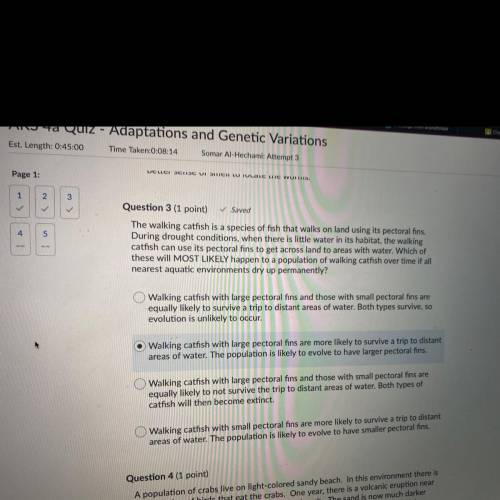
Biology, 27.05.2021 01:00 ashtonbillups
The walking catfish is a species of fish that walks on land using its pectoral fins.
During drought conditions, when there is little water in its habitat, the walking
catfish can use its pectoral fins to get across land to areas with water. Which of
these will MOST LIKELY happen to a population of walking catfish over time if all
nearest aquatic environments dry up permanently?
Walking catfish with large pectoral fins and those with small pectoral fins are
equally likely to survive a trip to distant areas of water. Both types survive, so
evolution is unlikely to occur.
Walking catfish with large pectoral fins are more likely to survive a trip to distant
areas of water. The population is likely to evolve to have larger pectoral fins.
Walking catfish with large pectoral fins and those with small pectoral fins are
equally likely to not survive the trip to distant areas of water. Both types of
catfish will then become extinct.
Walking catfish with small pectoral fins are more likely survive a trip to distant
areas of water. The population is likely to evolve to have smaller pectoral fins.


Answers: 2
Another question on Biology

Biology, 22.06.2019 00:10
Which is an example of a decomposer? a. bear b.algae c.grass d.bacteria d bacteria
Answers: 2

Biology, 22.06.2019 06:00
Onsider the paragraph above. what is one chemical property of water? a) water is a polar molecule. b) water is the universal solvent. c) water reacts with group 1 metals. d) water has a high specific heat capacity.
Answers: 1

Biology, 22.06.2019 09:00
Hurry i need your (100 points) 1) what are the responsibilities of the region of the brain highlighted below? (picture located below) the highlighted portion is at the rear base of the brain, behind the brain stem. regulating homeostasis, hunger and eating, thirst and drinking, and many other functions of basic survival. coordinating movement and balance by using information from sensory nerves, including hand-eye coordination. controlling voluntary body movements, processing information from sense organs, thoughts, and learning abilities. regulating important involuntary bodily functions such as blood pressure, heart rate, breathing, and swallowing. 2)which of the following systems or structures is correctly paired with its function? neurons - brain cells that control thoughts, calculations, and memory cerebral cortex - portion of the brain that controls involuntary body movement peripheral nervous system - carries impulses to and from the central nervous system central nervous system - carries information from the nerves to the muscles and glands
Answers: 1

Biology, 22.06.2019 15:00
Which description shows competition in an environment? an organism that feeds on some food an organism that finds a place to sleep three organisms of the same species living in an area three organisms battling over limited resources
Answers: 3
You know the right answer?
The walking catfish is a species of fish that walks on land using its pectoral fins.
During drought...
Questions

Physics, 08.02.2021 08:30

Mathematics, 08.02.2021 08:30

Health, 08.02.2021 08:30


Chemistry, 08.02.2021 08:30


Business, 08.02.2021 08:30




Mathematics, 08.02.2021 08:30

Mathematics, 08.02.2021 08:30



Mathematics, 08.02.2021 08:30





World Languages, 08.02.2021 08:30



